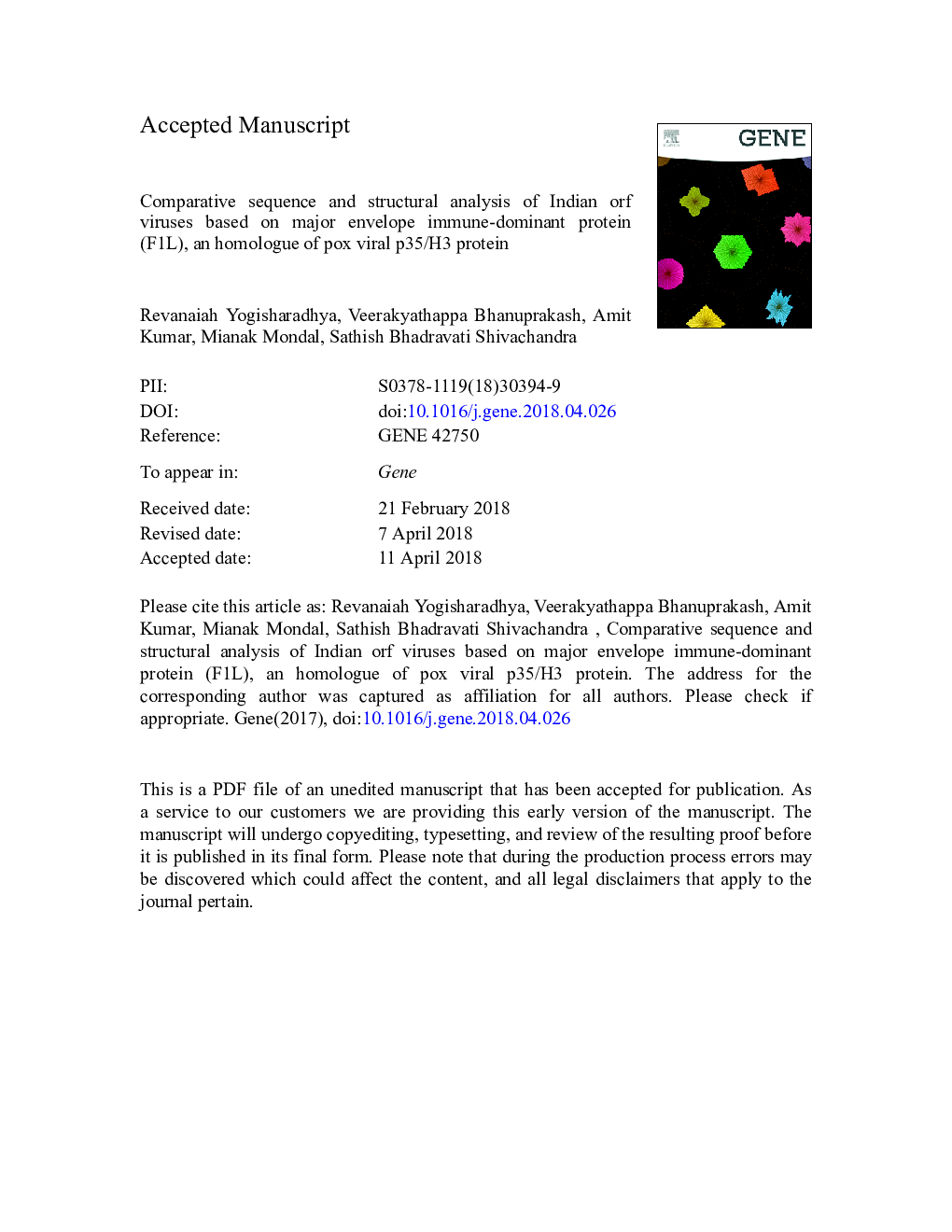| کد مقاله | کد نشریه | سال انتشار | مقاله انگلیسی | نسخه تمام متن |
|---|---|---|---|---|
| 8645002 | 1569773 | 2018 | 39 صفحه PDF | دانلود رایگان |
عنوان انگلیسی مقاله ISI
Comparative sequence and structural analysis of Indian orf viruses based on major envelope immuno-dominant protein (F1L), an homologue of pox viral p35/H3 protein
دانلود مقاله + سفارش ترجمه
دانلود مقاله ISI انگلیسی
رایگان برای ایرانیان
کلمات کلیدی
bovine papular stomatitis virusKGDPseudocowpox virusORFVproline rich regionICARVACVPRRGAGPPVamino acid - آمینو اسیدtransmembrane domain - دامنه فرابنفشMotifs - دلایلIndian Council of Agricultural Research - شورای تحقیقات کشاورزی هندNucleotide - نوکلئوتیدvaccinia virus - ویروس واکسیناسیونorf virus - ویروس ویروسStructural features - ویژگی های ساختاریParapoxvirus - پاراپوکسی ویروسPoxviruses - پس از ویروسGlycosaminoglycan - گلیکوزآمینوگلیکان
موضوعات مرتبط
علوم زیستی و بیوفناوری
بیوشیمی، ژنتیک و زیست شناسی مولکولی
ژنتیک
پیش نمایش صفحه اول مقاله

چکیده انگلیسی
Orf virus (ORFV), a member of the genus Parapoxvirus in the family Poxviridae, is the cause of orf, a highly contagious zoonotic viral disease that affects mainly sheep and goats. In the present study, the sequence and phylogenetic analysis of Indian ORFV isolates (nâ¯=â¯15) from natural outbreaks in sheep and goats belonging to different geographical regions were analysed on the basis of F1L gene along with homology modelling of F1L protein. Multiple sequence alignments revealed highly conserved C-terminus and heterogeneity of N-terminus region of F1L among all orf viruses studied. Further, a comparative sequence alignment indicated conservation of various motifs such as glycosaminoglycan (GAG), Asp/Glu-any residue-Asp (D/ExD) and a Cx3C chemokine like motif among all poxviruses and unique motifs (proline rich region [PRR] and Lys-Gly-Asp [KGD]), in parapoxviruses including ORFV isolates irrespective of geography and host species. Phylogenetically, two major clusters were noticed which included Indian orf isolates along with foreign isolates. Structurally, ORFV F1L resembled the topology as exhibited by its homologue vaccinia virus H3 protein with mixed β/α folds and ligand binding specificity in docking models. We noted that despite differences in host cell specificity and pathogencity, poxvirus proteins especially ORFV F1L protein and its homologues presumed to share similarities as they are highly conserved irrespective of species and countries of origin. Further, the study also indicated the possibilities of differentiation of ORFV strains based on N-terminal heterogeneity despite highly conserved C-terminal region with conserved motifs.
ناشر
Database: Elsevier - ScienceDirect (ساینس دایرکت)
Journal: Gene - Volume 663, 15 July 2018, Pages 72-82
Journal: Gene - Volume 663, 15 July 2018, Pages 72-82
نویسندگان
Revanaiah Yogisharadhya, Veerakyathappa Bhanuprakash, Amit Kumar, Mainak Mondal, Sathish Bhadravati Shivachandra,